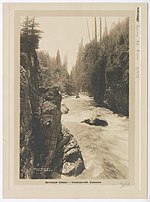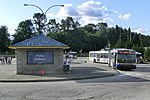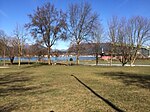Ironworkers Memorial Second Narrows Crossing

The Ironworkers Memorial Second Narrows Crossing, also called the Ironworkers Memorial Bridge and Second Narrows Bridge, is the second bridge constructed at the Second (east) Narrows of Burrard Inlet in Vancouver, British Columbia, Canada. Originally named the Second Narrows Bridge, it connects Vancouver to the North Shore of Burrard Inlet, which includes the District of North Vancouver, the City of North Vancouver, and West Vancouver. It was constructed adjacent to the older Second Narrows Bridge, which is now exclusively a rail bridge. Its construction, from 1956 to 1960, was marred by a multi-death collapse on June 17, 1958. The First Narrows Bridge, better known as Lions Gate Bridge, crosses Burrard Inlet about 8 kilometres (5.0 mi) west of the Second Narrows. The bridge is a steel truss cantilever bridge, designed by Swan Wooster Engineering Co. Ltd. Construction began in November 1957, and the bridge was officially opened on August 25, 1960. It cost approximately $23 million to build. Tolls were charged until April 1, 1963.The bridge is 1,292 metres (4,239 ft) long with a centre span of 335 metres (1,099 ft). It is part of the Trans-Canada Highway (Highway 1).
Excerpt from the Wikipedia article Ironworkers Memorial Second Narrows Crossing (License: CC BY-SA 3.0, Authors, Images).Ironworkers Memorial Second Narrows Crossing
Trans-Canada Highway, Vancouver Hastings-Sunrise
Geographical coordinates (GPS) Address External links Nearby Places Show on map
Geographical coordinates (GPS)
| Latitude | Longitude |
|---|---|
| N 49.295296 ° | E -123.026276 ° |
Address
Ironworkers Memorial Second Narrows Crossing
Trans-Canada Highway
V5K Vancouver, Hastings-Sunrise
British Columbia, Canada
Open on Google Maps








